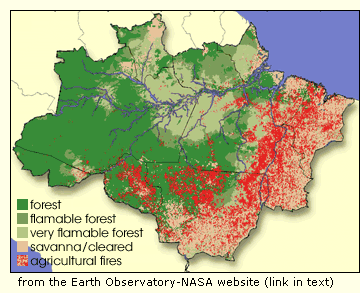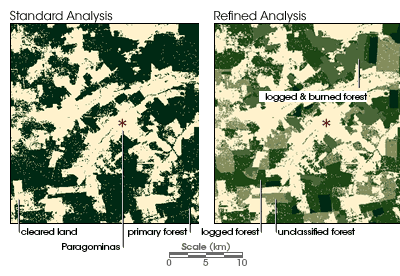

|
| weblog/wEssays | home | |
|
Deforestation and Sustainable Forestry (September 14, 2005)  The difficulty in saving the Amazon is people--the ever-growing number of usually impoverished people
trying to eke out a living in what is fundamentally a fragile, easily degraded habitat with poor soil.
The difficulty in saving the Amazon is people--the ever-growing number of usually impoverished people
trying to eke out a living in what is fundamentally a fragile, easily degraded habitat with poor soil.
This map, and the accompanying article on NASA's Earth Observatory website show that fire, both intentionally set slash-and-burn agricultural fires and those started accidentally, is fast consuming the entire Amazon. The authors' studies, conducted over a 20-year period, reveal that the damage caused by fires extends far beyond the land that has been cleared by logging and slash-and-burn agriculture; any fire opens an exposed area of land which, as it dries out in the Amazon's dry months, becomes increasingly vulnerable to more fires. 
As a result, previous estimates of deforestation have radically under-reported the actual amount of forest which has been damaged, perhaps fatally. There are a host of other inter-related problems eroding the Amazon. Roads cut by logging companies are pernicious in several ways: they enable slash-and-burn farmers to extend deeper into heretofore virgin forests, and they balkanize the forest into areas which are too small to support full-spectrum habitats. (E.O. Wilson states that reducing an area by a third may destroy half of the creatures and plants who once thrived in the larger parcel.) Since people, and their governments, already occupy the Amazon, the only way forward is to foster rules and plans which make their livelihoods sustainable, so that the remaining forest can be preserved. One essential step in many to reach this goal is to gather reliable data on natural reforestation of previously logged parcels--just what Ashton's team accomplished. The complexities of sustainable forestry will require another entry; not all trees in the forest are economically harvestable, and not all have commercial value. Each species has a different minimum "footprint" and a different number of "parent trees" required for re-propagation. Such research as depicted below is the necessary pre-condition to establishing truly sustainable logging in the Amazon. The solution is to utilize the land which has already been cleared or disturbed--such as the previously logged land Ashton's team studied. Nurturing the land which has already been degraded with sustainable practises means that the inhabitants have less need to destroy virgin lands to make their living. * * * copyright © 2005 Charles Hugh Smith. All rights reserved in all media. I would be honored if you linked this wEssay to your site, or printed a copy for your own use. * * * |
||
| weblog/wEssays | home |